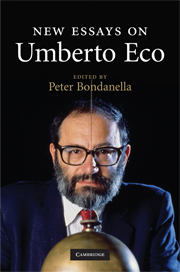Book contents
- Frontmatter
- Contents
- Notes on contributors
- Preface
- Acknowledgments
- 1 Eco and popular culture
- 2 Eco's semiotic theory
- 3 Eco's scientific imagination
- 4 From the Rose to the Flame: Ecos theory and fiction between the middle Ages and postmodernity
- 5 Eco's middle Ages and the historical novel
- 6 Eco and the tradition of the detective story
- 7 “The subject is in the adverbs.” The role of the subject in Eco's semiotics
- 8 Double coding memorabilia in The Mysterious Flame of Queen Loana
- 9 Eco and Joyce
- 10 Eco on film
- Selected bibliography on Eco
- Index
10 - Eco on film
Published online by Cambridge University Press: 26 January 2010
- Frontmatter
- Contents
- Notes on contributors
- Preface
- Acknowledgments
- 1 Eco and popular culture
- 2 Eco's semiotic theory
- 3 Eco's scientific imagination
- 4 From the Rose to the Flame: Ecos theory and fiction between the middle Ages and postmodernity
- 5 Eco's middle Ages and the historical novel
- 6 Eco and the tradition of the detective story
- 7 “The subject is in the adverbs.” The role of the subject in Eco's semiotics
- 8 Double coding memorabilia in The Mysterious Flame of Queen Loana
- 9 Eco and Joyce
- 10 Eco on film
- Selected bibliography on Eco
- Index
Summary
Let me only subreptitiously add that I do not believe it is possible to understand the social relevance and the aesthetics functioning of a movie without focusing it from a semiotic point of view. But…qui l'ho detto e qui lo nego, in this precise moment I say this and in this precise moment I deny to have said it. (Umberto Eco, “on the Contribution of Film to Semiotics,”
Quarterly Review of Film Studies, 2, 1(1977): 1–14)In Eco's History of Beauty – an excursus on aesthetic ideals of the beautiful, the sublime, and the marvellous from antiquity to the present – the author begins in the last chapter to discuss contemporary media as distinguished respectively by beauty of “provocation” and beauty of “consumption” (Umberto Eco (ed.), History of Beauty. trans. Alstair mcEwen New york: Rizzoli, 2004, pp. 413–18). whereas the former category is associated with avant-garde artists such as Picasso, beauty of consumption belongs to the mass media and finds its privileged habitat in the cinema. Pictures of classic movie stars from Rita Hayworth and Anita Ekberg, flamboyantly featured in stills from Gilda and La Dolce Vita, to James Dean and marcello mastroianni, are displayed to underscore the “totally democratic” quality of film, offering “a model of Beauty” for everyone, whether they identify with the “svelte Audrey Hepburn” or the “blue-collar charm of Robert De Niro” (pp. 420–5). It is, however, not merely through the star system that the cinema invites the audience to participate in its aesthetic and communicative practices.
- Type
- Chapter
- Information
- New Essays on Umberto Eco , pp. 157 - 170Publisher: Cambridge University PressPrint publication year: 2009



